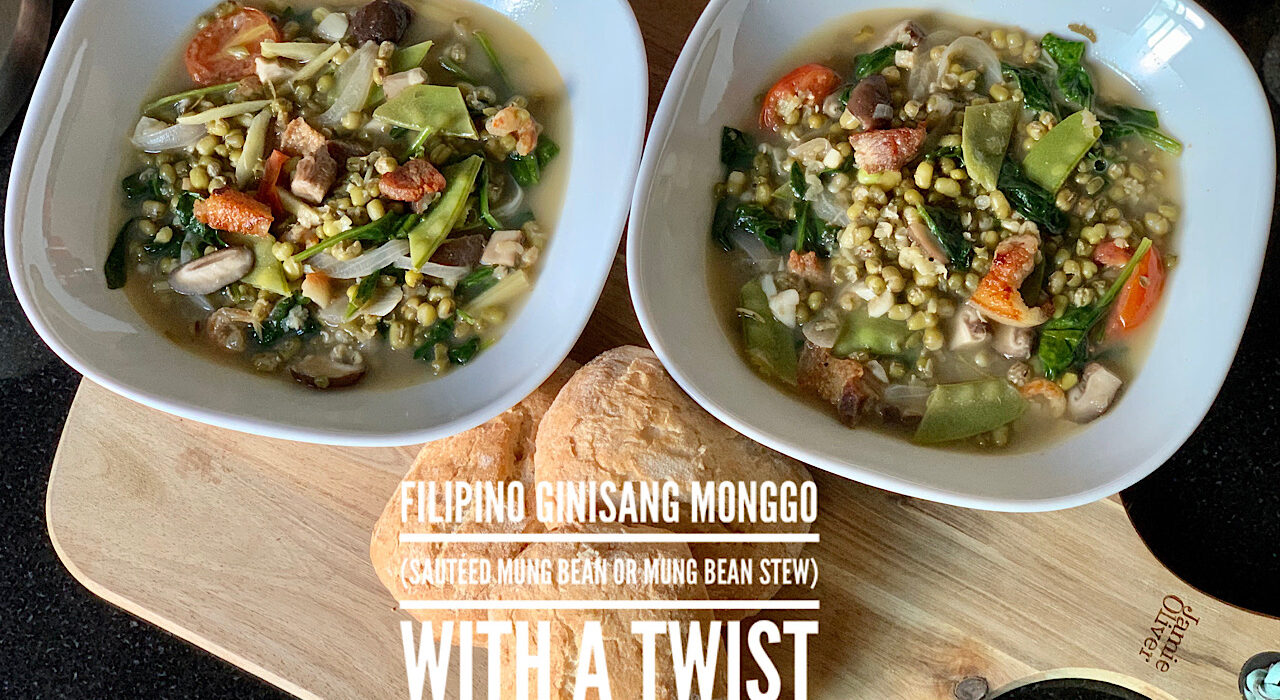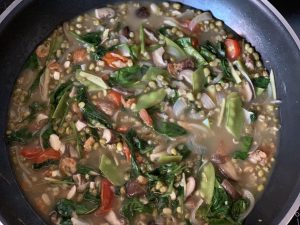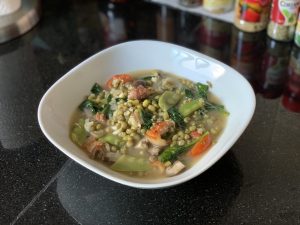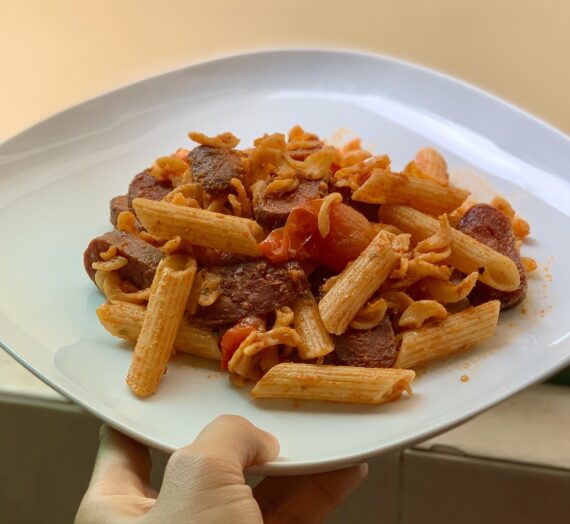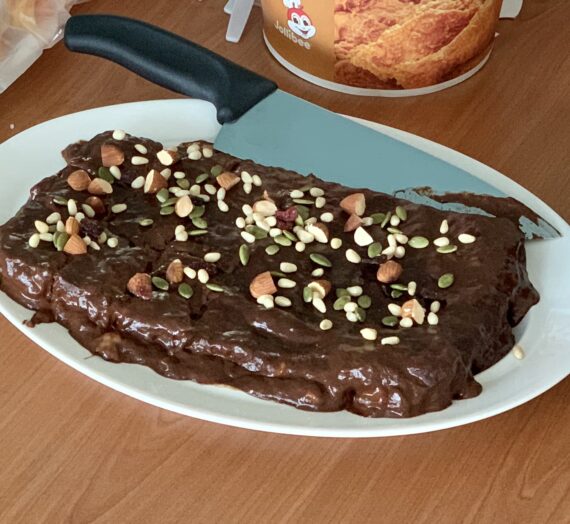Some other Filipino dish I got inspired to try 😍. And since Singapore has been raining cats and dogs lately, thought to make something hot, soupy, and yummy! So I was thinking that why not make one from my home town that’s considered a healthy meal 😉, then I thought of this Filipino Guisado Monggo (Mung Bean Stew) with a twist, you’ll know why as we go through this recipe…
It is very popular in the Philippines and commonly served especially during the rainy season, why? Because it’s soupy and hot; definitely a perfect meal for cold weather. And you might be thinking why it’s called Guisado (Sautéed) when it’s a soupy dish. According to Wikipedia – the name refers to the first step of the cooking process. Usual ingredients of this meal apart from mung beans would be pork, tomatoes, fish sauce (Patis), smoked fish (Tinapa), dried fish (Daing), spinach, or drumstick leaves (Malunggay).
Let’s begin…

TOTAL TIME: 45 minutes to 1 hour
YIELD: 4-5 Servings
What kitchen stuff you need?
You need wok with lid and a slotted/wooden spoon.
Ingredients
- 1 cup Mung Beans (cooked)
- 144gms Pork Belly (cube-size cut)
- 1/2 tsp Olive Oil
- 10pcs Cherry Tomatoes (cut into half)
- 5 Medium-sized Shiitake Mushrooms (sliced)*
- 45gms snow peas (cut into 3 pcs)*
- 1 pack or a bowl of Spinach
- 1/2 cup of Chicken Stock, alternatively use water
- 4 medium cloves of garlic (crushed and chopped)
- 1 medium red onion (thinly sliced)
- 25gms Dried shrimp *
- 36gms Ginger (thinly sliced)
- 1 1/2 tbsp Mixed Dried Spices (Coriander, Parsley, Rosemary, Paprika, Chilli Powder, Oregano, and Onion Powder)*
- Salt & Pepper to taste (Optional)
Instructions
- I soaked the Mung beans overnight, rinse, and cook in medium-low heat for about 25 minutes. Check this very helpful post for How To Cook Mung Beans 😀
- In medium heat, sauté cube-sized pork belly. For about 10mins or until water evaporates, add Olive oil for pork belly easily generate its own oil. Check again for another 5 minutes or until it turned brown. Put it in a bowl, set aside.
- Using the same pan, sauté onions, garlic, and sliced ginger for 2-3minutes.
- Slowly add tomatoes, add cooked mung beans along with its remaining water. Add in the chicken broth, stir, cover and let it simmer for about 6 minutes.
- Add on the mushrooms, snow peas, half portion of the mixed dried spices, stir, cover the pan, and let it slowly boil.
- Next Spinach, the remaining portion of the mixed dried spices, and dried shrimps stir for a minute and cover again to bring it to a boil.
- Last, put in the remaining cooked pork belly, salt, and pepper to taste (Optional). Stir for a minute, cover and let it simmer for 1-2 minutes.
- Remove from the heat. Set aside. Let it cool down for 1-2 minutes.
- Top it up with the remaining cooked pork belly and ready to serve.
In the Philippines, normally it served with rice, but for me, I served it with gluten-free pieces of bread. Your choice 😉
And there you have it, my version of Filipino Guisado (Mung Bean Stew) with a twist 😍. The difference; I’ve added mushrooms, snow peas, dried shrimps, and only using mixed dried spices instead of putting more salt and fish sauce (Patis). With great health benefits and a super tasty dish – definitely recommended for you to try and cook at home 👍.
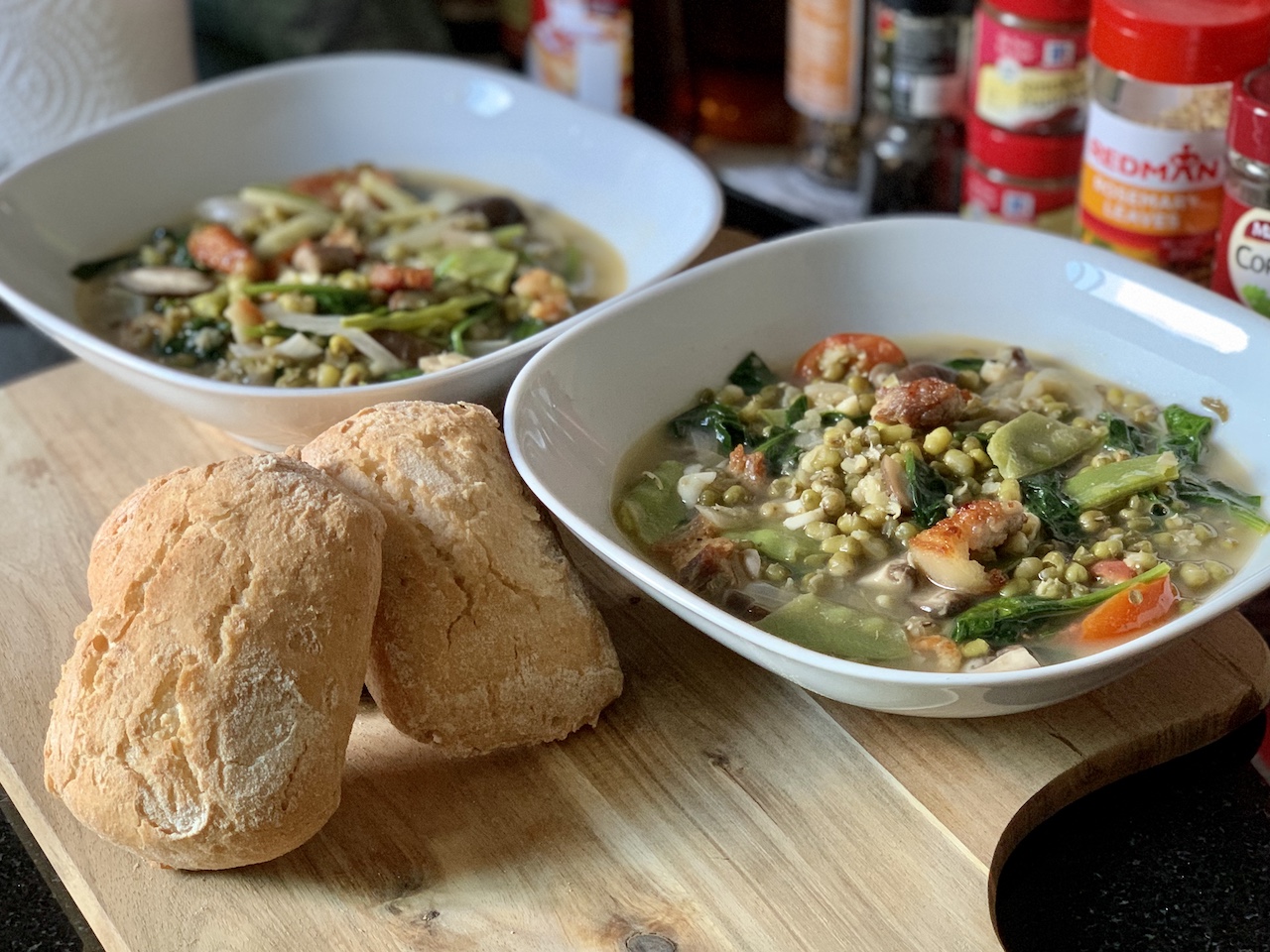
Filipino Ginisang Monggo (Sautéed Mung Bean or Mung Bean Stew) with a Twist
Ingredients
- 1 cup Mung Beans (cooked)
- 144 gms Pork Belly (cube-size cut)
- 2 tsp Olive Oil
- 10 pcs Cherry Tomatoes (cut into half)
- 5 pcs Medium-sized Shiitake Mushrooms (sliced)*
- 45 gms Snow Peas (cut into 3 pcs)*
- 1 pack Or bowl of Spinach
- 1/2 cup Chicken Stock, alternatively use water
- 4 cloves Medium Garlic (crushed and chopped)
- 1 pc Medium Red onion (thinly sliced)
- 25 gms Dried shrimp *
- 36 gms Ginger (thinly sliced)
- 1 tbsp Mixed Dried Spices (Coriander, Parsley, Rosemary, Paprika, Chilli Powder, Oregano, and Onion Powder)*
- Salt & Pepper to taste (Optional)
Instructions
- I soaked the Mung beans overnight, rinse, and cook in medium-low heat for about 25 minutes. Check this very helpful post for How To Cook Mung Beans 😀
- In medium heat, sauté cube-sized pork belly. For about 10mins or until water evaporates, add Olive oil for pork belly easily generate its own oil. Check again for another 5 minutes or until it turned brown. Put it in a bowl, set aside.
- Using the same pan, sauté onions, garlic, and sliced ginger for 2-3 minutes.
- Slowly add tomatoes, add cooked mung beans along with its remaining water. Add in the chicken broth, stir, cover and let it simmer for about 6 minutes.
- Add on the mushrooms, snow peas, half portion of the mixed dried spices, stir, cover the pan, and let it slowly boil.
- Next Spinach, the remaining portion of the mixed dried spices, and dried shrimps stir for a minute and cover again to bring it to a boil.
- Last, put in the remaining cooked pork belly, salt, and pepper to taste (Optional). Stir for a minute, cover and let it simmer for 1-2 minutes.
- Remove from the heat. Set aside. Let it cool down for 1-2 minutes.
- Top it up with the remaining cooked pork belly and ready to serve.In the Philippines, normally it served with rice, but for me, I served it with gluten-free pieces of bread. Your choice 😉
Video
Most of my cooking recipes, you’d noticed that I used less salt because I want to avoid being bloated and feeling swollen. If you’re a regular reader of my cooking posts, you’d know that I am conscious of what I eat 😉. But of course, my cooking recipes and/or style is good for everyone that’s looking for easy and tasty food 😍.
Thanks for reading and checking this version of mine. If you find this interesting, please give it a 👍. Do drop a comment if you want to share your version or if you have any questions. I would be very happy to answer you 🙏❤️.
You can follow my social media accounts as well where I post my favorite traveling experiences 📷, my new music covers, my dance moves, and of course my cooking clips 🎙️
– Instagram, Pinterest, Facebook, Youtube, and Twitter
Photographs
All photos and videos taken by me and only using my iPhone. Basic filter used and portrait mode – to enhance the quality of the subject.

